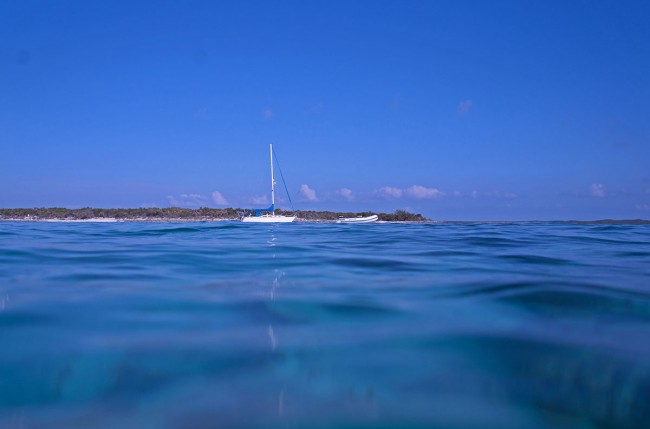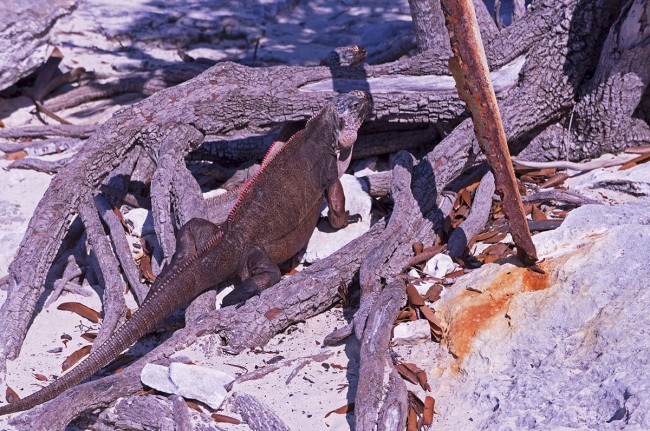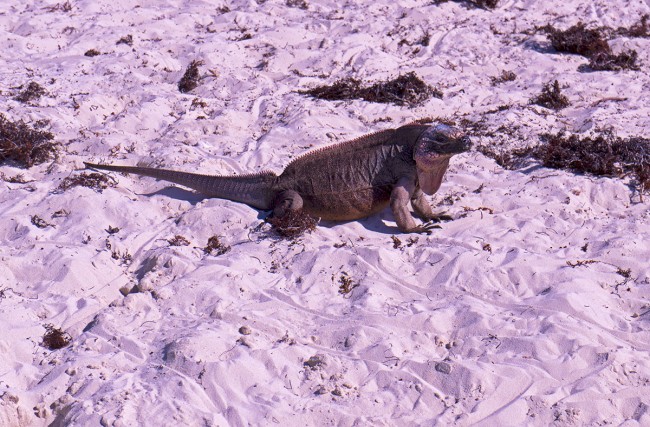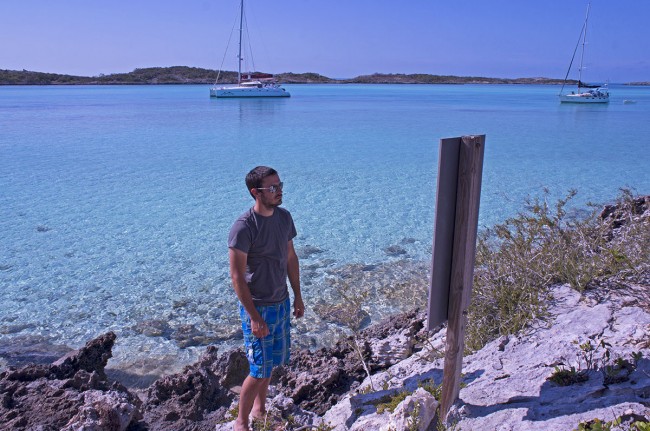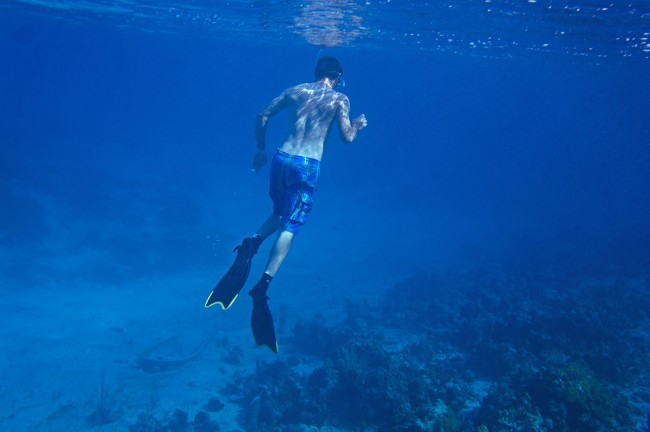Wednesday March 20, 2013
Getting ourselves up before the crack of dawn once more, the goal was to make it across the Great Bahama Bank and over to the Exumas. Making sure to fill up with fuel on our way out, we did not want to make the journey out of civilization on just fumes. We were a little surprised when the bill came, it was close to $6.50 a gallon! I was still willing to pay it though, knowing that we had to navigate our way out of the East Harbor at Nassau, and I was not going to do that under sail power alone. Even before we got into the harbor I had looked at the East and West entrances, just to check them out. We were coming in from the West where all the cruise ships and commercial traffic do, so it was wide and deep and easy to navigate. Looking on our charts at the east side, all I could see were red dots with X’s on them, marking rocks and coral. It may have well just had a skull and crossbones on that side, since that’s what it looked like in my mind. It had been done by many people before us though, so we knew it was possible and very common to use that side to exit. Armed with two sets of charts (both electronic), we put Matt behind the wheel while I went up to the bow for visual navigation.
The water here is so unbelieveably clear that even in 15-20 feet you can see every spec of sand on the bottom. This meant that I’d be able to see any rocks or coral that we’d be coming up on, and guide Matt around them. I’m sure it’s normally a good practice in theory, but we were leaving just after the sun rose and it was right in our eyes. With the reflection off the water, I could barely make out more than 10 ft in front of the boat. (Or should I say 3 meters, now that we’re not in the states anymore?) For the most part it was just grass and sand, but there were two times when our sides just cut across those coral and I wasn’t able to see them until we were right on top. Luckily the water was deep enough that we didn’t come close to touching them, and behind the wheel, Matt was in ignorant bliss to what we had just passed over. Once that feat was over and we were out of the harbor, I was allowed back to the shade of the cockpit and out of the sun, which at 9:30 am, was already burning into my skin. Our next challenge for the day would be getting through an area known as the Yellow Bank. The charts and guide books label it as an area that’s littered with coral in 7 ft of water. If you happen to accidentally float over one of the corals this time, chances are it’s going to stop you dead in your tracks. The good news is that both our books and stories from friends that have made this crossing say it’s almost impossible not to make out the coral before you’re well in advance of it, and there’s plenty of time to move yourself around it. I hoped they were right.
Seated at the bow once more, this time armed with a wide brim hat, I told Matt to let me know when our depth was under 10 feet. At the moment we were still in the 17-20 ft range and had enough water below us to pass over every piece of coral if we felt like it (although I wouldn’t). While sitting and waiting, I could see what the guide books were talking about with the coral areas very easy to spot from a distance. Even in this deep of water, the bright aqua colors in front of us would be tainted by an almost black spot that you could see from a few hundred feet away. I figured that once the depth dropped and we needed to navigate around them, they’d be even easier to spot. So I sat and waited, and waited. Finally after an hour, Matt came up to the bow to join me. “What are you doing?!â€, I gasped, “You’re supposed to be ready to steer us around the coral!â€. “Yeah, we’re already through itâ€, he replied. What? Not only did our depth never get below 15 ft, but we never even passed close to a piece of coral. All this build up and anticipation for nothing.
With the Yellow Bank behind us, we were able to keep on our course for Allen’s Cay (pronounced ‘key’) which was to be our anchorage that night. The reason we chose this spot, although it’s at the very top of the Exumas, is that there are endangered iguanas roaming the island that we wanted to see. ETA had us getting there just after 3:00, and I figured that would still be plenty of time to hop in the dinghy and check them out. Getting ourselves into the sheltered anchorage between the few small islands there, I was under the assumption that we’d probably have the area to ourselves since it was so late in the season. Although the anchorage wasn’t packed, there were still about 6-7 other masts in the tiny area. Still learning how to read the colors of the water since this was our first day at it, we didn’t know if some of the dark areas meant ‘deep’ or ‘rocks’, so we quickly swung ourselves into 8 ft sandy bottom. Maybe a little closer to another boat than we’d prefer, but we heard anchorages in the Caribbean can be tight.
Dropping the dinghy down, we could see the the areas with the iguanas right across from us. Partly because it was only 200 feet away, but mostly because of all the other people hoarded in the area. I guess that in Nassau you can pay to have a speed-ferry boat race you out here for the day, and we happened to come at the time that two of these overcrowded monsters were already at the beach. Being later in the afternoon though, it didn’t take them long to leave and then we had the place to ourselves. Reading in our guide books that these iguanas aren’t the friendliest of creatures and may actually bite, I supposed I should have been wise in keeping my distance from them, but instead I chased them down the beach for a photo-op. None of them wanted to seem to pose for me, and each time I’d crouch down and get within a few feet they’d always scurry away. Once I had my fill of trying to photograph them, but definitely keeping my hands away, we tried to hike the island a little which proved almost impossible. The dense brush and trees did not let us get very far and we moved back to the dinghy.
Not ready to end our afternoon just yet, we thought we’d take a stab at snorkeling. This was high on both of our list of things to do as soon as we were in water that permitted it. The only time I’d ever done it in my life was when my parents had taken me to the Bahamas on vacation 18 years ago, and Matt’s actually never been in his entire life. We were both excited to break out our new snorkel gear and get in the water. Holding hands like a couple of high school girlfriends, we took the plunge together into the clear refreshing water. Both of us managed to get in the water without a huge mouthful of salt water, which was a giant plus. Sticking our heads under water, we began swimming and scanning the sand for anything interesting. For 20 minutes we swam with only seeing a few beer bottles and one fish on the bottom. The current began cutting through quicker than I had been anticipating so it wasn’t long before I was seeking the shelter of Serendipity and taking of my gear, while Matt continued around through the little islands. I was just about ready to crack open a cold beverage when he began waving and came back to tell me that the coral lining the islands was full of fish and I really needed to get back in the water to check them out.
Since it was quite a swim and the current had already tired me out we took the dinghy and dropped anchor. Putting on my gear once more I was surprised at all the underwater life surrounding me. Everywhere I looked were little fish, darting in and out of coral heads. The current in this area was also not as strong, so we were able to just float above and watch. Taking turns, we’d dive under the water and try to brush against them and check out their little hiding spots. As far as activity was concerned we could have stayed there for hours watching, but even 78 degree water gets chilly after a bit and we found our way back to the dinghy. Wrapping myself up in a towel I went back to my chilled margarita in a can. We both sat up there enjoying the late afternoon and our arrival in paradise. Getting buzzed on Margaritaville and sunlight, we watched as a new boat came into the already crowded area to anchor. I don’t know why anyone thinks this is a good idea, as we’ve seen it done a few times before, but this boat allowed their anchor to drop as they were still going full speed ahead, basically running over any chain that was being laid down. It made us nervous to have them anchoring improperly so close to us, but they must have realized it wasn’t working because they circled back around to grab it and left the anchorage.
While they were leaving a mega yacht in the 160 ft range happened to be on it’s way in. Wondering where they would drop and how much swing room they’d allow themselves before we’d all start playing bumper boats, they did the same thing as the first boat where they were still moving forward while the anchor went down. What was even more disturbing was that they were headed right for an area of coral that was sticking out of the water. We figured they had to be professionals since there was obvious paid crew on deck, but we still didn’t know how they were going to pull it off. Pulling some kind of Houdini maneuver, they were able to swing the aft end of the boat around and steer clear of the coral. In essence it was almost like the Captain Ron docking of where you see it coming and you’re waiting for the train wreck, but they pull it off perfectly. We just sat there in awe and wondered how we could learn how to do it. I’m sure it had a lot to do with bow thrusters which is definitely not happening on our boat, so maybe we’ll just have to settle for watching it. Just as we finished watching that show, the boat that had tried anchoring earlier was on it’s way back in for a second attempt. Dropping the anchor down in the same style as the first time they still didn’t look like they were doing it in any way that seemed correct in our mind, but this time they were far enough away that it wasn’t as much cause for concern. Their bow was pointed at our stern, so if they were going to drag, at least it wasn’t going to be into us. Let’s just hope that the winds don’t shift overnight.

